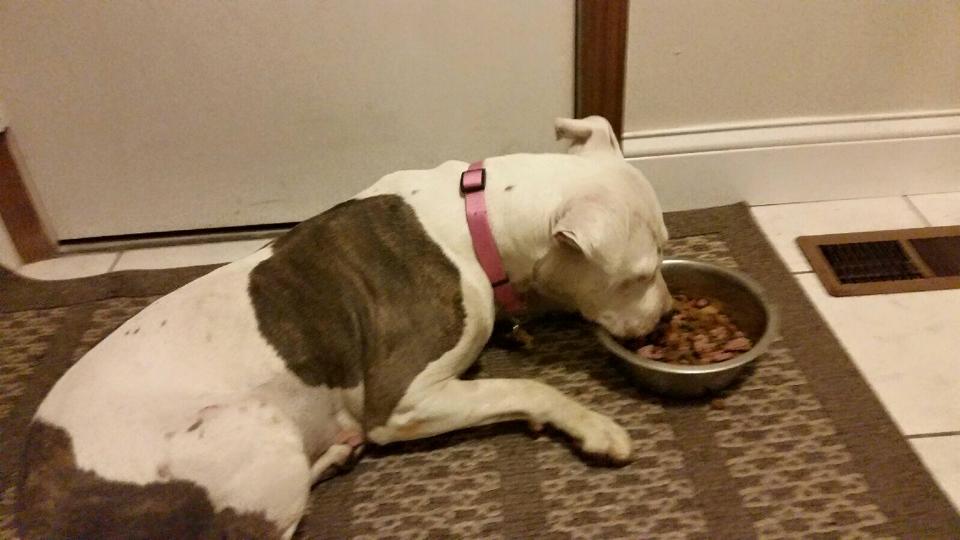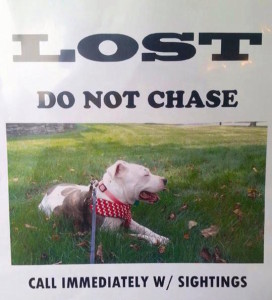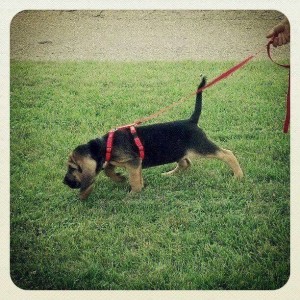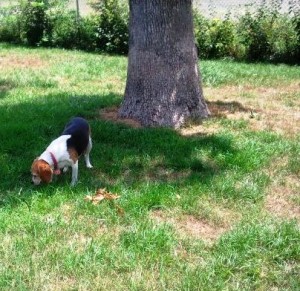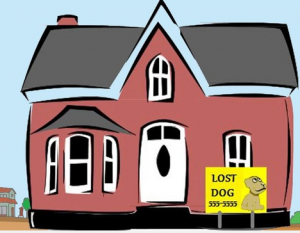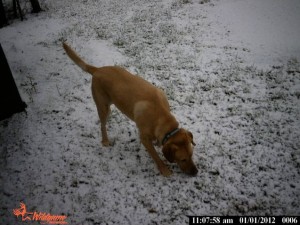On April 30, I pulled up to a house, and I saw a proud new father in his driveway holding his son. I exited my vehicle and introduced myself. A few hours before, I had seen a post on Facebook about a local family dog, Champ, that was missing. As soon as I could, I contacted the owner, Jeff, to learn more about his dog. He told me Champ had gone missing the night before. He was a large, brindle 10 year old male Lab/Boxer mix, with a white chest, red collar, and friendly disposition. I thought to myself, friendly, big, older dog; this should be easy. Unfortunately, I was wrong.
As Jeff held his son, he explained what had happened the night before: he was letting the dogs out before heading to bed. Champ and his brother, Jager, went out. Jeff let the dogs back in, or so he thought. He locked up the house and went to bed. In the morning, he discovered Champ was not in the house, and not outside. Champ was gone!
Champ’s information was immediately put up on the Lost Dogs Illinois Facebook page and other area pages. Soon, Jeff and his wife got the first call of many from people seeing Champ over the next 8 days. The first few calls had Champ heading
toward a nearby golf course. Jeff and Jess headed
out to look, then spent the day driving around
passing out fliers and talking to people in the
neighborhood. Many were now on alert and knew
to call them if he was spotted. That evening, with a heavy heart, Jeff and Jess went home without finding Champ.
The following day, I made more fliers, hoping to get them hung. I also put a flier on the back window of my car and encouraged others to do the same. I was getting stopped multiple times by people asking questions and telling me they were watching out for Champ. Jeff and Jess continued to get calls seeing Champ in the area of the golf course and by the red barn. As more people shared the posts of Champ missing, there were more cars in the area. That meant there were more eyes to spot him, but also more cars that could hit him, and people to chase him away. Another full day came and went without Champ home.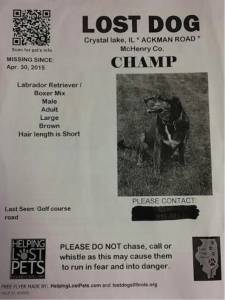
Champ was spotted but managed to slip into clever hiding places each time. I received a message around 10:15pm that night that Champ was now spotted a couple miles down at a park. He was just an arm’s length away from someone, but when they said Champ’s name, the dog turned and ran into the darkness of the park. Someone posted the sighting online and people arrived at the park using flashlights. A police officer even used his spotlight to help. However, if Champ was there, he was not going to come out with that number of people searching. Jeff took the shirt off his back,and put it and some treats under a play area he hoped Champ would go to for rest.
On Saturday morning Jeff woke early to check on his shirt and treats. No Champ, no change. Thinking that it was the weekend and that Champ would be ready to mingle, Jeff was sure he would go up to someone and would be home that evening. Families would be out in yards. Fathers would be barbecuing dinner, and the smells would lure Champ out of hiding! Jess also created the Find Champ Facebook page. Champ had 771 followers very quickly. The day passed and there were just 2 calls and still no Champ. Jeff and Jess put out another blanket and treats near the cornfields where they thought he may be.
Seeing Jeff and Jess looking a little defeated, I reached out to Susan from Lost Dogs Illinois. She knew Champ was missing, but I needed to fill her in on what we had been doing and ask for suggestions for next steps. She mentioned that Champ may not be seen for the same reason we thought he would be. Because it’s the weekend and a lot of people would be out, he would hide. I also inquired about using a tracking dog, and she said they do not recommend tracking dogs. They do not find dogs. She did suggest a feeding station and trail camera. She also offered, if needed, a large humane trap. After talking with Susan, I shared her suggestions with Jeff and Jess. They felt that setting up a humane trap would not be an option as Champ was a Houdini, and there was no way he would be kept in a trap if he went in. We set up a feeding station where he had been spotted on several different days which lead right to an area we would eventually call “Tick Field.”
The next morning we went to the feeding station hoping we would walk up and find Champ resting on his blanket with a full belly of chicken and bacon. My heart sank. The bowl was untouched. I went home and printed a map marking all the sighting locations. I was trying to see if there was any pattern to his movements. For a few days it seemed he was on the golf course during the day and park at night. If this was true, where was he hiding?
Monday was uncomfortable. Silence is usually a blessing, but this time we would have welcomed the phone ringing and it wasn’t. No one was calling – was Champ ok?
Tuesday morning was an eventful one. Jeff and Jess started receiving calls at 6am. Champ was spotted walking down a road. Then, he was on a path behind an elementary school. This was the closest Champ had gotten to home. We wondered with the rain from the night before, were all the scents being picked up and he was on his way home? Again, people were posting all over social media and the area had people everywhere. Champ once again outsmarted everyone and slipped by. At this point, Jeff and I were thinking how crazy it is that Champ has been seen by everyone else but us. We had spent every free minute looking for him and hanging fliers and talking to people, and Champ never showed himself to us. I asked for help to post fliers in this new area. I was going up and down the streets placing Champ’s information by the mailbox flags. I knew we could not place anything inside a mailbox. I noticed a mail truck coming our way and was happy to see it. In recent days I had been able give other mail carriers a flier that was happily received with well wishes for finding Champ. This was not the case with this time. She ignored my 2 attempts to get her attention and then turned her truck around and started up the other side of the street where I had just been and watched her as she went up to the mailboxes and took the fliers. Shocked, I looked at the other volunteer and said, “She is taking the fliers!” He was just as stunned. He caught up to her truck and asked her why she was taking them since they were about a lost dog. She snapped at him something about postage and drove off. I called the post office to find out that no one is allowed to put anything inside or on a mailbox.!
Wednesday went by without a single call. Jeff and I began to walk behind the houses into “Tick Field.” We were playing detective, not allowing Champ to be steps ahead of us anymore. This is when Jeff mentioned Champ also ‘army crawls’. I am out here looking for a brindle coated dog that would blend into everything that also army crawled! We found some fresh dog poop and a toy that had the stuffing newly pulled out (this is something Champ would do). As we walked, Jeff was pulling ticks off of himself. Jess showed up and had Jager, Champ’s dog buddy, with her. He seemed to walk a path they felt was where Champ walked. When we exhausted our “research” of this area we headed to the car. While walking back to the car, Jess about stepped on a snake. Thankfully she saw it before, stepped back and we concluded it was just a garter snake. WHEW!
Thursday was another quiet day with no calls. I had just finished checking the feeding station when Jess called. It was about 8:15pm, and she had just received a call from a couple of girls who were out on their bikes and saw Champ. He was over by the gates by the beach. This was about 2 miles from the last place he was seen on Tuesday. I was close to the street so I headed over. We had not had any calls since Tuesday morning, and there was still a constant flow of cars and people looking – Champ had moved somewhere quieter. I heard a ruckus in a yard when I pulled into the gates where he was said to have headed. It was really dark by this time, and it made it very difficult to see. I also knew I could not say his name without him running, so I was praying for backup, just in case. That’s when Jeff pulled up. We canvassed the street and yards, not expecting too much. We went down to the gate where he was first spotted before the girls called his name and he ran. There, we met another woman who saw him too. She said he was standing, sniffing around. He was there long enough for her to pull out her phone and bring up his picture, she was 100% sure, it was Champ. The concern about cars was even greater now. As we stood there, cars sped by. We couldn’t afford other people looking for him to add to the traffic on the roads. Even worse, Champ could run into the road!
Thankfully, we moved fast. One woman had already posted the sighting on FB, but we were able to delete it before anyone saw it. I talked to Jeff, asking him to keep this quiet, just between a small group of us for Champs safety. Let’s let him get comfortable, even if it took another day or two. We called it a night shortly after to allow Champ the space to find a place to rest and be safe for the night.
Friday morning, both Jeff and I did a quick drive around before work. Neither of us saw anything, which was okay though. For the first time I actually felt that Champ was safe. SUDDENLY, at 2:42pm, I received a text. This is what I saw: “Look who I have!” I couldn’t believe my eyes! I was incredibly happy for Jeff and Jess. Champ looked good. Now, what was the story?
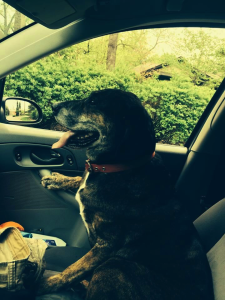
Well, after the Tuesday morning sightings, it seems that Champ headed down toward the beach through the gates. He took up residence under a deck. A gentleman had spotted him, but was unaware that Champ had been missing for all these days. While we were on call for sightings, a relationship was building between Champ and this man. In the morning he would give Champ pancakes, and for lunch he would have some chicken. This afternoon, Champ came out for a little love and his new friend was able to get the phone number off Champs tags and call Jeff. As you can imagine, with this news Jeff rushed over to the house. Champ was under the deck. There was only one way in and one way out. Jeff walked to the back and he whistled “his whistle” and Champ came out like a flash to greet his dad. After a few minutes of hugs, kisses, and tears, Jeff thanked the man and headed home with Champ. I was able to stop by their house within the next hour. I was so happy to meet this big boy that led us on an expedition that lasted for 8 days!
Champ’s travels took him to the golf course, through corn fields, by the red barn, the park, on bike paths, digging in backyards, trotting under windows, and traipsing through the woods. He came through it all with an abundance of ticks and only a small cut on his paw. Other than that, he was tired and a little clingy, but Jeff was just fine with that as long as Champ was home.
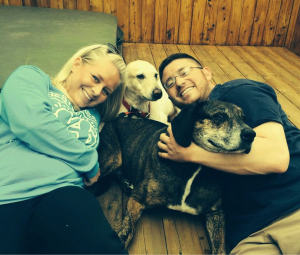
Here are some of the important things I learned while searching for Champ:
- I think the most important thing I learned was that having a ‘core’ group is crucial.
- Too many people responding to a sighting pushes a dog further away.
- Dogs get to a point when running scared where they won’t answer, no matter how friendly they are or who is calling them
- Keeping some information quiet is best for the safety of the dog.
- Set aside your emotions and think of the dogs safety first .
Finally, I was reminded that we live in such a wonderful community. I have
seen again how one dog can bring people together, and now, I have 2 new amazing people in my life ‐ Jeff and Jess, and, of course, Champ and his dog buddies at home. That little boy Jeff was holding when I first stopped over is in for an exciting story when he grows up!
Sidenote: We want to thank Kerry, Jess and Jeff for sharing their story about Champ. LDI’s mission is to empower our dog loving communities with resources, tools and tips on how to find lost dogs. The more knowledge that is disseminated; the more dogs will be returned home safely.

